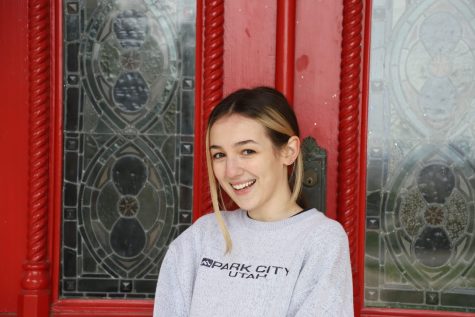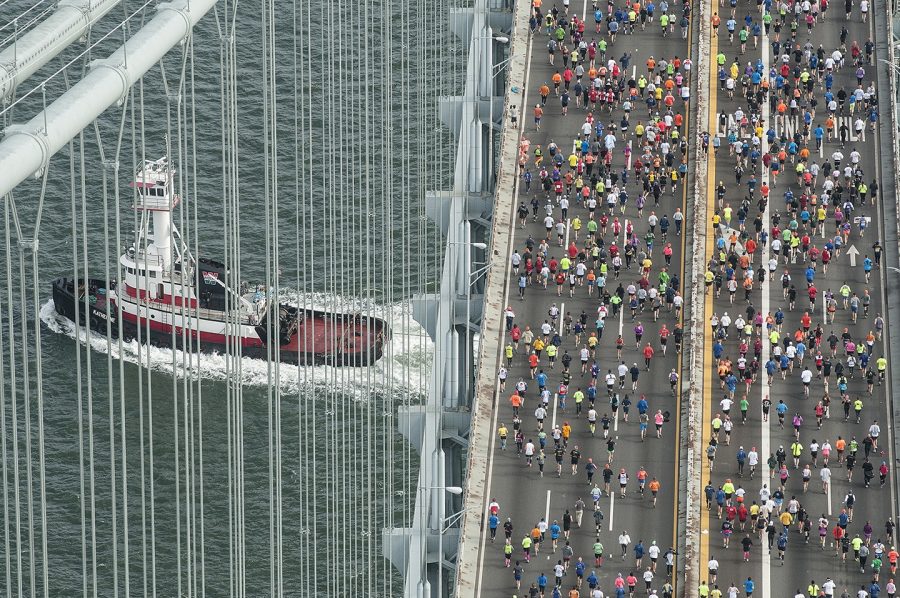Pandemic causes postponement, cancelation of marathon races nationwide
Metropolitan Transportation Authority / Patrick Cashin / Wikimedia Commons
An aerial shot taken on Sunday, November 3, 2013, when the Verrazano-Narrows Bridge hosted the first mile of the New York City Marathon. This year’s race in the same location was cancelled, suffering the same fate as many others due to the ongoing impacts of COVID-19.
In light of the COVID-19 pandemic, marathon racing has become yet another sport being put off or handled with extreme safety measures; something that is not always possible due to the amount of people attending these events.
The New York Marathon, which would have been held on Nov. 1, was cancelled on Wednesday. The marathon began in 1970 and became the largest in both runners and spectators in the country. It has also been suspended for the second time in history; the first time in 2012 because of Hurricane Sandy. Runners who were signed up for the marathon were given the option to receive a full refund, use their entry within the next three years or run the race virtually.
The Boston Marathon suffered a similar fate, as its registration is being postponed, and the race signup is being changed to April 2021, with hopes that the race will happen in the Fall of the same year.
Both the New York and Boston Marathons are international events that attract an average of 30,000 participants and 500,000 spectators. With these numbers, it is quite difficult to make changes in order to adapt to the pandemic and make safety a priority.
Not all marathons have been cancelled, though. In fact, Texas has had several marathons during the pandemic. The Dallas Marathon’s 50th anniversary on Dec. 13 is still planned to take place while providing a safe environment for those attending. Despite the larger scale marathons that welcome people from around the world, the Dallas Marathon mostly consists of locals from Dallas and Fort Worth, with 90% of the runners being Texas residents, according to The Dallas Morning News.
Marathon organizers in Texas have been implementing changes in order to offer the safest environment possible for both runners and spectators. In Bankersmith, Texas, at the Scallywompus Battle of Helotes Half Marathon on Oct. 17, runner Missy Fraser said that masks were required “until we took off” and “after [we] finished.” At the start of the race, “10 people in a group” were released thirty minutes apart in order to separate the runners as best as possible, Fraser said.
Despite the virus running rampant, the show must go on. Runners need to take the precautions advised in order to ensure maximum safety for themselves and others, but their goals don’t have to be stolen by fear. When asked if she was afraid of racing, athlete Nusha Bladinieres said, “No, I think race organizers are working with the city to make sure that precautions, and safety measures are being taken for athletes and spectators.”
Three weeks before the Oktoberfest Half Marathon at Bryan-College Station in Texas, it transitioned into a virtual race because of health concerns. Although the race was not technically cancelled, there is a daunting difference between running with others and running alone.
“The joy of racing live is the exponentially high level of energy prior to and during the race. The satisfaction of accomplishment and joy; of physically crossing the finish line, with hands in the air. In the end, I did not register for the virtual Oktoberfest Marathon for the simple reason of zero energy being present,” runner Jim Jones said.
With the risk of getting sick, marathons are a difficult business because of the amount of people present. Sports in general have been largely impacted by this virus, but the efforts to keep things like marathons in place, even if they are postponed or virtual, is what helps keep runners sane and people safe.

Hey there! I'm Nicco Pelicano, your friendly neighborhood Viewpoints editor. I'm a writing & rhetoric major with a concentration in creative writing...


